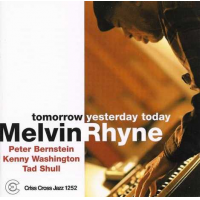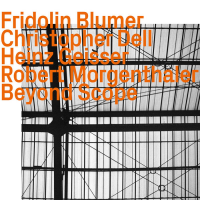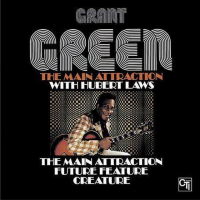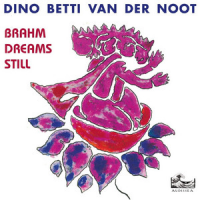Home » Jazz Articles » Liner Notes » John Abercrombie: The First Quartet
John Abercrombie: The First Quartet
"When Manfred [Eicher] gave me the opportunity to record Timeless, that was my first real break; it helped me find my own way, because I was basically a John McLaughlin rip-off at the time," Abercrombie recalls, chuckling. "And then I wrote two tunes that pointed toward something else. 'Ralph's Piano Waltz,' my first legitimate composition, was a jazz waltz, and "Timeless," my second, was a sort of floating, atmospheric thing; I have no idea where it came from. So, all of a sudden I thought, 'I do have something here; there is something going on.'"
While attending the Berklee College of Music in the mid-'60s, Abercrombie met bassist George Mraz and drummer Peter Donald. "We all lived in Boston around the same time; I think George attended Berklee for about six months and realized that there was nothing they could teach him," Abercrombie says, "so he became a local working musician. I went through the whole program because there was nothing else to do, sharing an apartment with George and Jan Hammer.
"I first met Peter at jam sessions and gigs. He was one of the first to really encourage me to play the way I play. And so, George, Peter and I found ourselves in various situations, and we would get together and have jam sessions. Then I moved to New York, where I met [pianist Richie] Beirach, and we just naturally gravitated towards each other. We became friends, and I played on some of [saxophonist] Dave Liebman's records, including Lookout Farm (ECM, 1974)."
By Lookout Farm, the unique relationship which continues to this day had already formed between Richie Beirach and Liebman. Blending a jazz tradition stemming from Herbie Hancock, McCoy Tyner and Bill Evans, with his love of and early schooling in classical music, Beirach's singular approach juxtaposed a strong sense of swing with a similarly potent romantic impressionism. "There's a tune on Dave's Sweet Hands (Horizons, 1975), 'Dr. Faustus,' that I played with Richie—an open-ended rock jam featuring a long guitar solo over a pedal point," says Abercrombie. "Every time I played a phrase and landed on a note, it seemed like Richie was there with me, with what seemed like the perfect chord. He's really an incredible musician."
In addition to forming the collective Gateway trio with Jack DeJohnette and bassist Dave Holland (releasing its ECM debut, Gateway, in 1975), and his duo with guitarist/pianist Ralph Towner (first documented on Sargasso Sea (ECM, 1976)), Abercrombie recorded Characters (ECM, 1978) in late 1977, a solo album of multilayered acoustic and electric guitars, plus the electric mandolin guitar that would become his primary instrument for the next few years. "It was really a soprano guitar," Abercrombie explains, "tuned an octave higher than a guitar. But Fender originally marketed it as an electric mandolin, tuned in fifths. I was at a jam session where [Mahavishnu Orchestra violinist] Jerry Goodman showed up with one. I thought it sounded so cool; the next day I bought the last one they had at Manny's, and that became my instrument.
"I hadn't been paying much attention to writing; I just wanted to be a jazz guitarist, and I didn't know what I wanted to write. I think I was so immersed in trying to play like other people that I never really looked into myself to see what there might be. I had a loft on Sixth Avenue with an old upright piano, and then Manfred gave me a Revox reel-to-reel two-track tape recorder as a gift. So, all of a sudden I had a piano and a tape recorder—tools that inspired me to write and fool around with overdubbing things on the tape recorder; trying to play tunes on the piano to learn how to play harmony and see what was in my head—trying to put those Berklee years to use. I tried to learn standards on the piano, and started writing my own little ditties.
"I'd been playing a lot of fusion music in the early '70s, and I realized that I didn't want to play that kind of music for the rest of my life; I really wanted to play jazz. I wanted to go back to my roots and pick up where I left off. It was important to me and I wasn't really getting the chance to do that, so having a band with Richie, George and Peter really inspired me and propelled the writing.
And so, Abercrombie formed his first group. "[ECM label head/producer] Manfred [Eicher] had never heard George play," says Abercrombie. "When I mentioned him as the bassist I wanted to play with he said, 'Oh, he's a bebop player,' and I said 'Yeah, but that's not what we're going to be recording.' And when he heard George, he just flipped; this was like Scott LaFaro all over again. He realized what a tremendous musician George was, and felt the same way about Peter, who reminded him of Pete La Roca.
"I was meeting new people, making new friends, hearing new music and getting influenced, not only by the music I'd heard on recordings and from my past, but from my friends' music—music that was starting to break out of the norm. They weren't bebop tunes; they were becoming a little more impressionistic. There was more space in them, the harmony more ambiguous—what they refer to now as 'nonfunctional harmony,' an interesting term because it actually functions really well, just not in a normal standard song setting."
"I started to realize that I loved standards, but I also loved the stuff that was coming from all my friends. I began to find my own way of doing some of the harmony, yet it didn't sound like Ralph or Richie. That was the interesting thing; there was their influence, but the tunes didn't sound like them at all; these were different, sounding almost like standards."
Abercrombie contributed two tunes to Arcade: the esoteric, repetitive motif-based title track and "Paramour," a tune first recorded on Characters that further demonstrated how far the guitarist's writing had come. Arcade doesn't sound like a nascent group still finding its way; Beirach recalls the performances as "tentative," but Abercrombie elaborates, "They were fresh, but maybe the band was a little more fragile at that point, since we hadn't really developed a way to play together yet. The whole idea was that this band and the kind of tunes we were playing—a guitar-led quartet with me playing on this little mandolin guitar—were different from what was going on at the time."
Judicious overdubbing lent Arcade a more expansive sound; in particular, Abercrombie's layered acoustic guitar on the title track and the orchestral timbre of Mraz's overdubbed arco on Beirach's brooding "Neptune." Arcade's chamber vibe is surprising, perhaps, given the quartet's collective résumé to that point. First, there was Abercrombie's fusion background, admitting to playing "on some of the worst fusion records ever made in the '70s." Mraz and Donald were more rooted in straight-ahead jazz with artists like Oscar Peterson, Roland Hanna, and the Toshiko Akiyoshi-Lew Tabackin Big Band. On paper, only Beirach seemed prepared for this quartet's esoteric, eclectic and spacious music.
"So here I am, not only writing but performing, because I didn't perform with the Timeless band, nor did I perform Characters live," says Abercrombie. "Here I was, with a repertoire and three other musicians that I loved to play with, and we got a chance to go out and do it."
Beirach is even more emphatic: "We did four or five tours of Europe every year. We played every festival. That's how we got it together; we played every night. In New York we had the [Village] Vanguard, then down the block, Sweet Basil, and then St. James and across the street, the Brecker Brothers' Seventh Avenue South. It was a dream."
It was an exciting time, but Manhattan was a long way from Oslo, where Arcade and Abercrombie Quartet were recorded, and Ludwigsburg, where the sessions for M took place. With Eicher producing, the quartet became a de facto quintet. Beirach recalls: "If you had a little trouble, Manfred would say, 'Why don't you play rubato?'—and a lot of the time he was correct. We would do a ballad in time, and it was good but it sounded a bit too much like 'Blue in Green.' Manfred was right; we'd do it rubato and it would be perfect in one take. Or we'd be doing something a little too fast, and he'd say, 'Do it slower,' or 'Do it in three.' He'd say, 'Why don't you play a long intro and do the tune with no piano solo,' because it was too long and tunes can't absorb three long solos unless they're in three separate formats. So, have an intro and two solos; or have George play a solo intro and have me play an outro."
On Hubris (ECM, 1978), Beirach remembers how Eicher could turn a session around. "It was my first solo record; I'm nervous, because it's not just a solo record, it's a solo record after Keith Jarrett, Paul Bley and Chick Corea. So I played the music like I had practiced it, and it really sucked. I was playing all these decorations that had nothing to do with the essence of the music. So Manfred stops me and says, 'Stop decorating the room. Leave off the wallpaper. Play the room. Don't play the background.' So I did that, we did the record in two hours and it came out great. And we also learned to trust his ears because his mixes were always perfect. "
"Usually his suggestions were very general," Abercrombie continues, "He'd put you in a different frame of mind. Occasionally he would single out a player, one time asking me, 'Why did you play so many notes in that solo?' I answered, 'Because I can.' We both had a laugh about it, but I when I listened to the two different takes, he was right; the take where I didn't play so much was better. A lot better. I thought I was playing great and here I was meandering, and playing too many notes and not enough substance. Peter had a great saying: 'There's a lot of heat, but no light.' I love that, because there may be lots of energy and heat coming off the bandstand or record, but where's the light? Where is the meaning to it all?"
By the time the group recorded Abercrombie Quartet, it had racked plenty of road time, not just working Arcade but also the music that would ultimately appear on its second album. Abercrombie and Beirach contributed three songs each, making it a more compositionally balanced record. "I was starting to write tunes like 'Foolish Dog'—the real name was 'Foolish Door,' it was just a typo—that involved a lot of harmonic motion and different kinds of harmony, but still set up, for lack of a better word, in a traditional way," says Abercrombie. "I was also writing modal tunes like 'Blue Wolf.' Most tunes were written on piano; because my chops were so limited, I would write much simpler. The other tunes came out on guitar and I was able to express myself in a more complicated manner."
The absolute antithesis of tentative, Beirach's "Riddles" demonstrates just how hot this quartet could be while, at the same time, leaving plenty of space. "I wrote 'Riddles,' a song with a Bo Diddley bass line, for John," Beirach says. Featuring a relatively rare solo from Donald and demonstrating just how finely honed the quartet's chemistry had become, the drummer adds, "When John first talked with me about the group in the mid-'70s, we were living in different cities pursuing different careers. But the idea not only seemed like a dream musical setting; it also had a sense of inevitability about it, like we had been heading toward this moment for years." "Abercrombie Quartet was the closest to how the band sounded live, In terms of energy," says Abercrombie. "I'd play streams of cascading notes sometimes, and it all sounded good to me. But that was the approach of the band live. Arcade was pretty; Abercrombie Quartet was more powerful. "
While many guitarists rely on stock phrases, Abercrombie was instantly recognizable without ever repeating himself. "Most guitarists have a personal vocabulary, which is fantastic, which is what you're supposed to have," says Beirach. "But when they improvise they put in these particular riffs. Now, it's their language; it's them. But John comes from Jim Hall and Bill [Evans]—real improvisers from scratch. So it's always John, because he's got his sound, but it's no clichés. John's a real improviser. Guys like McLaughlin, George Benson or Pat Martino are great, but they're riff-oriented. Guys like Abercrombie are motif-driven; the motif is introduced in the first couple of bars of the solo—just like Beethoven or Bach. Other guitarists are very familiar and easy to follow, but I'd rather hear John play something I've never heard before."
Abercrombie Quartet may reflect the quartet's live sound, but Eicher's stamp remains fundamental. "He'd use the word 'panorama,' more like film director kind of talk," Abercrombie recalls. "He always said, 'Make it sound like it came from the same place, and not from separate cubicles,' even though we might have actually been in cubicles."
Relocating to Ludwigsburg's Tonstudio Bauer for M, Abercrombie preferred the sound and feel of Oslo's Talent Studio. "The Ludwigsburg studio was a bigger room with a lot of reverberation built into it. Even though they were good, I always felt that albums recorded there had a rawer, harder quality than the Oslo recordings," says Abercrombie. "The Oslo albums always sounded more refined."
M proved to be the group's most difficult recording. "For example, I wrote 'Boat Song' as a longer composition in a different time signature," Abercrombie recalls. "It wasn't in 4/4 like it is on the record, and It had the same kind of melody, but a little more complicated. For some reason we were having trouble getting it together in the studio and Manfred thought it just sounded too jumbled; it wasn't connecting.
"So we took a break, I sat down at the piano and edited the song, taking away the odd time signature and extra bass notes, just using the chord changes and simple melody and rewriting it in four. And then, Manfred got this idea that I should make this gong-like sound in the beginning, which I did in several passes and he linked them together. So that's how it starts out: with this big, gong-like effect, which is me just hitting the back of the neck of the guitar and moving the different voicings around. Not a very difficult thing to do, but it creates a certain atmosphere, like ships out at sea."
That effect was accomplished on the electric 12-string guitar that also figures even more heavily on Abercrombie's singable title track, one of M's most memorable compositions, which Gateway would also play." It was a hard record to do," says the guitarist. "My memory was that everything went down smoothly with the other two. But by the third one, it just it started feeling like more of the same, though if I listen to the record today, it sounds completely different. That's what's really cool; the three albums don't sound at all alike. But maybe, in our minds, we felt like we were starting to sound the same. M is a good record, but I always thought that the other two were much better. The few moments on M that I think are good are really good, but as a whole, it wasn't as musical; it was more of a burning record."
Hindsight being 20/20, looking back at M now, it's difficult to agree with Abercrombie. There are tunes that burn, to be sure, like Beirach's "Flashback," where the pianist explores a pedal point at length and Abercrombie engages in an incendiary duet with Donald. "I love playing a pedal point," Beirach enthuses. "Everything is up for grabs—that's what modern means: C pedal is not C minor. It means whatever you want at that moment. It's your point of view of the world, in that tune. That was really a defining moment. You'd had chromaticism since Bach, but, everything that Bach wrote that was chromatic—and he wrote some heavy shit— resolved.
"What makes music modern is that you don't have to resolve a chromatic note into the chord. You leave it out. And that also transfers to suspension of rhythmic phrasing. The problem with bebop is that there was this imperative where everybody had to hit the 'one.' But then came Coltrane and Miles, and you didn't need the 'one' anymore. You were supposed to have it inside you. The same thing happened with melody: non-resolving harmonic tones made much more tension, which defined the Bill Evans Trio—harmony and the suspension of rhythms. That's why Bill had Paul Motian, because he never played the 'one.'"
Elsewhere, Abercrombie plays his delicate ballad, "To Be," on acoustic steel-string guitar, while Beirach opens his own waltz-time "Veils" with a lengthy, set-defining a cappella solo. The album ends with the only tune on these three discs not written by Abercrombie or Beirach. Mraz's haunting, arpeggio-driven "Pebbles" is one of only a few tracks to feature Abercrombie's electric mandolin, and its chamber feel brings things full circle, even as the chapter is definitively closed on one of Abercrombie's most important periods of growth, consolidation and (r)evolution.
Had the group felt differently about M, it would still have represented the end because Abercrombie was already thinking about something different. "I was becoming more interested in playing more electricy," he recalls. "Not fusion, but I wanted to say use a little more distortion, and I was starting to think about other things I wanted to do. I discussed it with everybody, saying, 'I don't know if you guys want to go in this direction.' Richie didn't want to do it at all. The other guys would've been into it, but then I realized that this band already had a way to play, so maybe I needed a different band. That's when I went formed my next band with Peter Erskine and Marc Johnson."
Beirach looks back fondly on the group. "The Abercrombie Quartet is one of my favorite groups that I was ever in. The thing about John is his tremendous sense of dynamics, from pianissimo to fortissimo; a great feeling for the blues; he can swing his ass off, which is amazing; and very interactive. Cats that are usually that swinging and that burning are not particularly interactive, but he is, because he's got it all. He's made a lot of records on ECM, and most of them are really very good, and some of them are great."
Donald also reflects on the quartet's lifespan: " Endless hours on airplanes, long punishing van rides that strung together one-nighters and club dates; we were prototypical (and somewhat dissolute) road warriors, making sublime music for small but dedicated audiences. It was amongst the high points of my musical career. And when the group dissolved, that, too, felt totally natural. Not a tear was shed. I was blessed to make great music with three of the best musicians on the planet. They are also my good friends. It doesn't get any better than that."
Time has moved on, and so have the members of this quartet: Abercrombie continues to make new music for ECM, with periodically shifting lineups; in addition to teaching in Leipzig, Beirach's visibility has risen in a reunited Quest, with Dave Liebman; Mraz remains a first-call bassist with everyone from Herbie Hancock and Richard Galliano to Jim Hall and Joe Lovano; and Donald, after backing everyone from Denny Zeitlin to Olivia Newton-John, gave up music and is now a social studies teacher.
But for this relatively brief period, from 1978 to 1981, four musicians came together to create a small but significant body of work that may have taken decades to find its way back into print, but is to be treasured and cherished all the more for it.
Liner Notes copyright © 2026 © ECM Records GmbH 2015. Used by permission of ECM Records, Munich..
The First Quartet can be purchased here.
Contact John Kelman at All About Jazz.
With the realization that there will always be more music coming at him than he can keep up with, John wonders why anyone would think that jazz is dead or dying.
Track Listing
CD1 (Arcade): Arcade; Nightlake; Paramour; Neptune; Alchemy. CD2 (Abercrombie Quartet): Blue Wolf; Dear Rain; Stray; Madagascar; Riddles; Foolish Dog. CD3 (M): Boat Song; M; What Are The Rules; Flashback; To Be; Veils; Pebbles.
Personnel
Additional Instrumentation
John Abercrombie: guitar, mandolin guitar, electric 12-string guitar, acoustic guitar; Richie Beirach: piano; George Mraz: double bass; Peter Donald: drums.
Album information
Title: The First Quartet | Year Released: 2015 | Record Label: ECM Records
Tags
PREVIOUS / NEXT
Support All About Jazz
 All About Jazz has been a pillar of jazz since 1995, championing it as an art form and, more importantly, supporting the musicians who make it. Our enduring commitment has made "AAJ" one of the most culturally important websites of its kind, read by hundreds of thousands of fans, musicians and industry figures every month.
All About Jazz has been a pillar of jazz since 1995, championing it as an art form and, more importantly, supporting the musicians who make it. Our enduring commitment has made "AAJ" one of the most culturally important websites of its kind, read by hundreds of thousands of fans, musicians and industry figures every month.
























